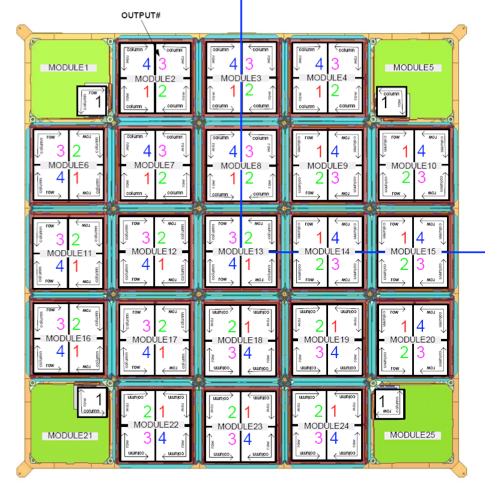|
|||||||||||||||||||
|
|
|||||||||||||||||||
USNO-KEPLER Catalog
 Fig 1: Schematic of the Kepler CCD array |
This data table has the proper motion information as well as the photographic plate magnitudes in approximate B, R and I passbands. These information are taken from the USNO B1.0 catalog through the use of the Virtual Observatory repository. This catalog is to be used as resource to find objects in the Kepler FOV that are fainter than the Kepler Input Catalog (KIC). The KIC is complete to about Kp ~ 16th magnitude, whereas the confusion limit of Kepler is about 20th. The USNO B1.0 catalog has a confusion limit of V = 21st mag (Monet et al. 2003), and this catalog will provide information of objects down to this magnitude limit. The objects found in this catalog all fall on silicon of the Kepler photometer. To see the distribution of the objects, see the associated image (Figure 2).
 Fig 2: Distribution of objects |
The catalog can be downloaded from the links below.
- USNO.fits.bz2 (95M)
- USNO.csv.bz2 (77M)
Use caution when using the USNO B1.0 photographic magnitudes since these are not on a standard system, such as the Johnson system. The uncertainties of the photographic magnitudes are approximately 0.25 mags (see Monet et al. 2003, section 5). For bright stars we have made use of the current version of the USNO catalog, which substitutes Tycho 2 measuements for deprecated values in the original catalog (see Monet et al. 2003, section 9). Many of the very large proper motions (mu > 500 mas/yr) listed from the USNO B1.0 may also be incorrect.
This research has made use of the USNOFS Image and Catalogue Archive operated by the United States Naval Observatory, Flagstaff Station (http://www.nofs.navy.mil/data/fchpix/). This research has made use of data obtained using, or software provided by, the UK's AstroGrid Virtual Observatory Project, which is funded by the Science and Technology Facilities Council and through the EU's Framework 6 programme (http://www.astrogrid.org/).
|
|
|




 Follow Us
Follow Us